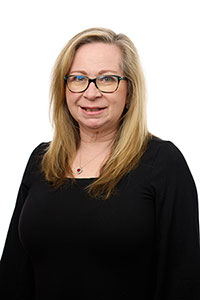
Samantha Brown got the idea for using clinical simulations with physical therapy students at a conference a decade ago. The practice of learning in the safety of a realistic but staged environment has a long history in aviation and physician and nurse training, but this was the first she had heard about simulations used in her field. “I was hooked,” she says.
Brown went on to establish Ithaca College’s first simulation facility before joining Sargent in 2022 as a clinical assistant professor of physical therapy. In January 2024, Sargent appointed Brown the inaugural director of clinical simulation, a role in which she oversees the college’s Center for Simulated Clinical Experience, or SIM Lab. “The SIM Lab allows students to practice their skills in a safe, nonconsequential environment, make mistakes, and learn from those failures,” says Sargent Dean Jack Dennerlein.
Brown spoke with Inside Sargent about the potential for simulations and creative ways that faculty and students are using the SIM Lab.
You’ve been involved in simulations for about a decade now. What trends have you seen in the use of clinical simulations?
When I first started to hear about simulation, it was very new in health and rehab. Now, there’s more research showing that it is an effective pedagogical tool in healthcare education. So it’s expanding and becoming more widely used for physical therapy, occupational therapy, nutrition, and speech–language pathology education.
Faculty members have used simulations in their classrooms in the past. How does the lab enhance what they can do?
Simulation is a team sport, and having the lab and an operations manager for the SIM Lab will allow support for more simulations and more education around standards of best practice for simulation in healthcare education. I see my role as assisting faculty and staff in developing their simulation expertise, following standards of best practice, providing or guiding the resources that we have available, and just making it easier and more attractive for faculty to use the lab.

What are some of the ways faculty have used the lab?
There’s a lot of creativity in our faculty, which is great. Leanna Katz [a clinical assistant professor in occupational therapy] is doing training on transfers in and out of hospital beds with patients who have lines and tubes and wires. I also use the lab for similar training with PT students. [Clinical Assistant Professors] Rachel Kammer and Kelly Hansen have developed an amazing series of simulations for their speech–language pathology students for bedside swallow evaluations. We can set it up as an acute care hospital or an ICU room or as someone’s home.
For students, the experience is about much more than learning a specific skill, isn’t it?
Yes. Some of the big things we look at are communication, patient interaction, and professional behavior. Is the student getting the emotions of being in a hospital room? We’re trying to get students ready to walk into a hospital or walk into a clinic and have an emotional connection to what’s going on.
What’s next?
One great thing that we’re going to use the lab for is interprofessional education, where students from different health professions learn about, from, and with each other. And one of the goals I have is to connect with other partners on campus and to hospitals and clinics in the area. How can we work together, and how can they support our students in this new way of learning?